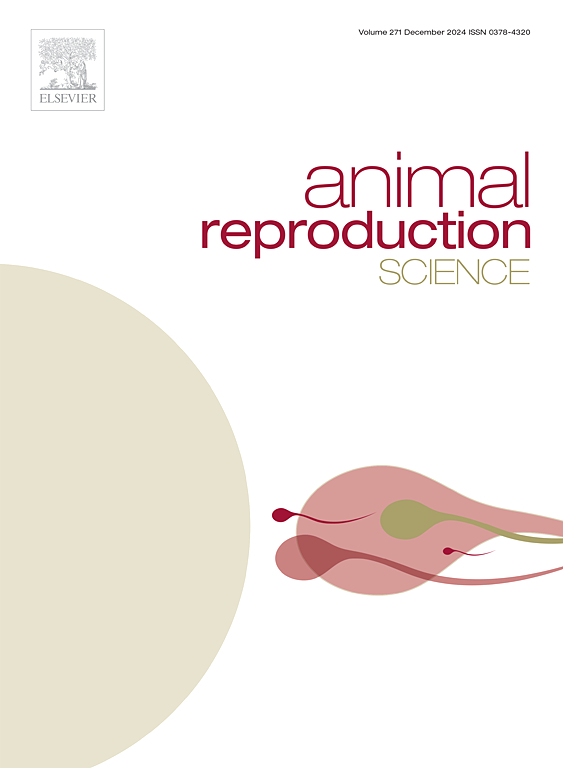Manipulation of metabolism to improve liquid preservation of mammalian spermatozoa
IF 2.2
2区 农林科学
Q1 AGRICULTURE, DAIRY & ANIMAL SCIENCE
引用次数: 0
Abstract
Reproductive success in mammals hinges on the ability of sperm to generate sufficient energy through cellular metabolism to perform the energy-intensive processes required for fertilisation, including motility, maturation, and oocyte interactions. It is now widely accepted that sperm exhibit metabolic flexibility, utilising a combination of glycolysis and oxidative phosphorylation (supported by the Krebs cycle and other complementary pathways) to meet their energy demands. However, the preferred pathway for energy production varies significantly among species, making it challenging to map species-specific metabolic strategies, particularly in species with high metabolic flexibility, like the ram. Additionally, differences in methodologies used to measure metabolism have led to biased interpretations of species’ metabolic strategies, complicating the development of liquid storage methods aimed at preserving spermatozoa by manipulating energy generation based on species-specific requirements. This review examines sperm energy requirements, current methods for assessing metabolic capacity, and the current research on species-specific metabolism. Future research should focus on establishing a standardised approach for determining metabolic preferences to accurately map species-specific strategies, a critical step before developing effective liquid preservation methods. By identifying species-specific regulatory points, strategies can be designed to temporarily inhibit metabolic pathways, conserving resources and reducing the accumulation of metabolic by-products. Alternatively, supplementation with depleted metabolites can be guided by understanding areas of excessive consumption during prolonged metabolism. Applying this knowledge to develop tailored preservation techniques will help minimise sperm damage and improve survival during in vitro processing and liquid storage, ultimately enhancing the success of artificial breeding programs.
操纵新陈代谢以改善哺乳动物精子的液态保存。
哺乳动物的生殖成功取决于精子能否通过细胞代谢产生足够的能量,以完成受精所需的能量密集过程,包括运动、成熟和卵母细胞相互作用。现在人们普遍认为,精子的新陈代谢具有灵活性,可综合利用糖酵解和氧化磷酸化(由克雷布斯循环和其他补充途径提供支持)来满足其能量需求。然而,精子产生能量的首选途径在不同物种之间存在很大差异,这使得绘制物种特异性代谢策略图具有挑战性,尤其是在具有高代谢灵活性的物种中,如公羊。此外,由于测量新陈代谢的方法不同,对物种新陈代谢策略的解释也存在偏差,这使得开发液体储存方法变得更加复杂,而这些方法的目的是根据物种的特定需求来控制能量的产生,从而保存精子。本综述探讨了精子的能量需求、目前评估新陈代谢能力的方法以及目前对物种特异性新陈代谢的研究。未来研究的重点应是建立标准化的代谢偏好测定方法,以准确绘制物种特异性策略图,这是开发有效液体保存方法前的关键一步。通过确定特定物种的调控点,可以设计出暂时抑制代谢途径的策略,从而节约资源并减少代谢副产品的积累。另外,还可以通过了解长期代谢过程中过度消耗的领域来指导补充耗竭的代谢物。应用这些知识来开发有针对性的保存技术,将有助于最大限度地减少精子损伤,提高精子在体外处理和液体储存过程中的存活率,最终提高人工育种计划的成功率。
本文章由计算机程序翻译,如有差异,请以英文原文为准。
求助全文
约1分钟内获得全文
求助全文
来源期刊

Animal Reproduction Science
农林科学-奶制品与动物科学
CiteScore
4.50
自引率
9.10%
发文量
136
审稿时长
54 days
期刊介绍:
Animal Reproduction Science publishes results from studies relating to reproduction and fertility in animals. This includes both fundamental research and applied studies, including management practices that increase our understanding of the biology and manipulation of reproduction. Manuscripts should go into depth in the mechanisms involved in the research reported, rather than a give a mere description of findings. The focus is on animals that are useful to humans including food- and fibre-producing; companion/recreational; captive; and endangered species including zoo animals, but excluding laboratory animals unless the results of the study provide new information that impacts the basic understanding of the biology or manipulation of reproduction.
The journal''s scope includes the study of reproductive physiology and endocrinology, reproductive cycles, natural and artificial control of reproduction, preservation and use of gametes and embryos, pregnancy and parturition, infertility and sterility, diagnostic and therapeutic techniques.
The Editorial Board of Animal Reproduction Science has decided not to publish papers in which there is an exclusive examination of the in vitro development of oocytes and embryos; however, there will be consideration of papers that include in vitro studies where the source of the oocytes and/or development of the embryos beyond the blastocyst stage is part of the experimental design.
 求助内容:
求助内容: 应助结果提醒方式:
应助结果提醒方式:


